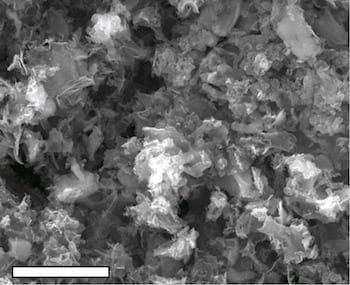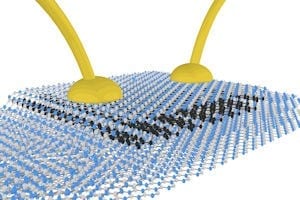
Rice University scientists find possible replacement for platinum as catalyst
Rice University chemists who developed a unique form of graphene have found a way to embed metallic nanoparticles that turn the material into a useful catalyst for fuel cells and other applications.
Laser-induced graphene, created by the Rice lab of chemist James Tour last year, is a flexible film with a surface of porous graphene made by exposing a common plastic known as polyimide to a commercial laser-scribing beam. The researchers have now found a way to enhance the product with reactive metals.
The research appears this month in the American Chemical Society journal ACS Nano.
With the discovery, the material that the researchers call “metal oxide-laser induced graphene” (MO-LIG) becomes a new candidate to replace expensive metals like platinum in catalytic fuel-cell applications in which oxygen and hydrogen are converted to water and electricity.
“The wonderful thing about this process is that we can use commercial polymers, with simple inexpensive metal salts added,” Tour said. “We then subject them to the commercial laser scriber, which generates metal nanoparticles embedded in graphene. So much of the chemistry is done by the laser, which generates graphene in the open air at room temperature.
“These composites, which have less than 1 percent metal, respond as ‘super catalysts’ for fuel-cell applications. Other methods to do this take far more steps and require expensive metals and expensive carbon precursors.”
Initially, the researchers made laser-induced graphene with commercially available polyimide sheets. Later, they infused liquid polyimide with boron to produce laser-induced graphene with a greatly increased capacity to store an electrical charge, which made it an effective supercapacitor.
Read more: Laser-burned graphene gains metallic powers
The Latest on: Metal oxide-laser induced graphene
[google_news title=”” keyword=”metal oxide-laser induced graphene” num_posts=”10″ blurb_length=”0″ show_thumb=”left”]
via Google News
The Latest on: Metal oxide-laser induced graphene
- Graphene articles from across Nature Portfolioon April 25, 2024 at 5:00 pm
Graphene is a two-dimensional material consisting of a single layer of carbon atoms arranged in a honeycomb structure. Its properties include high strength and good conductivity of heat and ...
- Laser-Induced Graphene Sensors for Wearable Gait Recognitionon April 15, 2024 at 7:53 pm
In a recent paper published in Microsystems & Nanoengineering , researchers integrated a pressure sensor array based on laser-induced graphene (LIG) and multiple sensor units into wearable gait ...
- Laser Induced Breakdown Spectroscopyon April 10, 2024 at 6:29 am
Analysis of Heavy Metal Pollution in Soil Using Transversely Excited Atmospheric CO2 Laser-Induced Plasma by Trapping the Soil in Microstructured Holes on Metal Subtargets. Applied Spectroscopy, Vol.
- News tagged with laser ablationon January 28, 2024 at 4:00 pm
Pulsed laser ablation in liquid (PLAL) is a reliable and versatile technique for producing metal nanoparticles ... reduce fused silica optics' laser-induced damage threshold (LIDT), which ...
- CMOS Technology Explainedon April 29, 2023 at 7:36 am
Complementary Metal-Oxide-Semiconductor (CMOS ... The wide voltage margin between these levels ensures that the circuit is less susceptible to noise-induced errors. The exceptional noise immunity of ...
- Artificially Intelligent Manufacturing (AIM)on December 16, 2021 at 10:14 pm
In addition, AIM PIs and associated researchers presented the latest results on applying state-of-the-art AI to laser-induced graphene production, atomistic modeling, and porous media modeling. The ...
- What is CMOS and what is it used for?on May 8, 2021 at 7:11 pm
CMOS or Complementary Metal Oxide Semiconductor is a small amount of memory in the motherboard of your computer and is used to store BIOS settings. They are very important for your computer as ...
- laser metal fusionon July 27, 2020 at 5:00 pm
Porsche is having these produced by Mahle in partnership with industrial machine maker Trumpf using the laser metal fusion (LMF) process. It’s a lot like selective laser sintering (SLS), but ...
- Graphene sieve turns seawater into drinking wateron December 18, 2018 at 9:30 am
New research shows graphene can filter common salts from water to make it safe to drink Findings could lead to affordable desalination technology Graphene-oxide membranes have attracted considerable ...
- Laser Etching Graphene Supercapacitorson October 2, 2015 at 6:57 pm
By placing a thin film on top of a DVD (or any plastic CD shaped disc), and coating it with graphite oxide, you can literally print patterns of graphene using the laser in your DVD burner.
via Bing News











